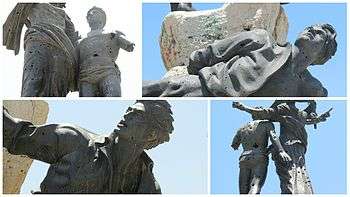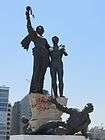Martyrs’ Monument, Beirut
The current Martyrs' Monument is a monument by Italian sculptor Marino Mazzacurati on Martyrs' Square in the heart of downtown Beirut, Lebanon. It was inaugurated in 1960.

Overview
The monument was built in honor of martyrs executed on May 6 in 1916 on what is now Martyrs’ Square, at the orders of Ottoman military ruler Djemal Pasha.
Construction
_-_Depicting_a_Muslim_woman_(R)_and_a_Christian_woman_(L)_with_outstretched_hands_over_an_urn_or_tomb.png)
In 1930, during the French Mandate, the first commemorative sculpture was erected on the square in memory of Lebanese and Arab nationalists hanged during World War I at the orders of Ottoman military ruler Jamal Pasha. The original monument (right) by Youssef Hoyek represented two women, a Muslim and a Christian, holding hands in a symbolic gesture over an urn that represented their martyred childrens' ashes. Hoyek carved on their chests a stylized shahada (لا إله إلا الله) and a small cross respectively.
In 1956, President Camille Chamoun laid the foundation stone of a monument conceived by architect Sami Abdel Baki. It would have consisted of an arch soaring over an obelisk, but the monument never materialized.
Today, the four-meter-high statue of the Martyrs that adorns the square was created by Italian artist Marino Mazzacurati, and inaugurated by President Fouad Chehab in 1960. Damaged during the Civil War (1975-1990), the Martyrs’ monument was dismantled in 1996 and restored by the Holy Spirit University of Kaslik. The restoration intentionally preserved the marks of war damage.
Timeline
- 1930: First commemorative sculpture was erected on Martyrs' Square in memory of Lebanese and Arab nationalists hanged during World War I by the Ottomans.
- 1956: President Camille Chamoun laid foundation stone of monument designed by Sami Abdel Baki which was never realised.
- 1960: President Fouad Chehab inaugurated the new sculpture of the Martyrs' Monument, designed by Marino Mazzacurati.
- 1996: Monument was dismantled and restored in the Holy Spirit University of Kaslik.
Pictures
 The monument at Martyrs' Square by Italian sculptor Marino Mazzacurati...
The monument at Martyrs' Square by Italian sculptor Marino Mazzacurati... ...was initially inaugurated in 1960.
...was initially inaugurated in 1960. It commemorates the hanging of a cross-confessional group of Lebanese Patriots...
It commemorates the hanging of a cross-confessional group of Lebanese Patriots... ... who had spoken against Turkish rule by Ottoman General Jamal Pasha in 1916.
... who had spoken against Turkish rule by Ottoman General Jamal Pasha in 1916. It was decided to keep the traces of the Civil War as a reminder.
It was decided to keep the traces of the Civil War as a reminder.
See also
- Jamal Pasha
- Youssef Hoyek
- Sami Abdel Baki
- Marino Mazzacurati
- Holy Spirit University of Kaslik
- Lebanese Civil War
References
- Kassir, Samir (2003) Histoire de Beyrouth, Fayard, Paris.
- Sassine Farès et Tuéni, Ghassan (direction) (2003) El-Bourj. Place de la Liberté et Porte du Levant, Editions Dar an-Nahar, Beyrouth.}}